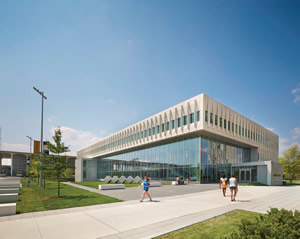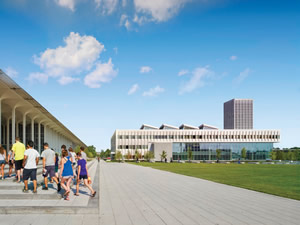Solid and Sustainable
- By Brandon Barrett
- 11/01/14

PHOTOS COURTESY OF PERKINS+WILL
Students may be the main elements that make your campus a great place, but construction materials are what make your campus a safe place full of resilient structures for those students to inhabit. When in the planning stages of a construction project, it may appear that all materials are created equally, each offering a unique set of benefits and drawbacks. Yet, one material consistently offers durability, versatility and the promise of low maintenance for years: concrete. What has made concrete a popular choice for builders in past centuries is what continues to make it a popular material today.
We know that the building envelope is responsible for keeping out the elements, managing moisture and ensuring sturdy construction. It is what makes a building strong or weak, energy efficient or wasteful.
How have colleges and universities harnessed the power of concrete in the building envelope? Some institutions have featured it in new building projects, especially those seeking LEED certification. Others have reshaped and modernized older buildings with equal success.
When Dale Beeler, the director of project management at the University of Cincinnati (UC) thinks about components for a new project, and especially the building envelope, concrete is always high on the list. "It is a fireproof, rust-resistant material and can have a 100-year life span," he notes. "With six current LEED-certified buildings on campus, the University of Cincinnati uses concrete for both its longevity and sustainability over time."
Robert Goodwin, design director for Perkins+Will Architects, notes this diversity when discussing recent projects utilizing concrete as a key component of the building envelope. "At the SUNY campuses [Albany and Buffalo], we used it to respect, re-interpret and transform the use of precast on the exterior of existing mid-century modern buildings that form the context for the new buildings. At Einstein [Regional Hospital in Philadelphia], it was used to create a more consistent, streamlined, 'high-tech' expression than traditional stone," he explains.

PHOTOS COURTESY OF PERKINS+WILL
Concrete is Hard… Except on the Environment
Concrete can help to ensure that your building project will be environmentally friendly and sustainable. One of the ways in which using concrete achieves this is through its high thermal mass. This means that it is able to slow the path of heat going into and coming out of buildings (via walls, floors, etc.).
With its high thermal mass, concrete ensures that warm air stays inside a space in the wintertime, and remains outside during the sweltering summer months. It also lessens the need for air conditioners or heaters to be turned up year-round, helping your institution save on energy costs.
According to the World Business Council for Sustainable Development (www.wbcsd.org), 80 percent of a building's carbon dioxide (CO2) emissions occur not when a building is being constructed, but during its subsequent life cycle. Concrete is able to lessen the damaging impact of these emissions, as it emits less CO2 than comparable materials such as aluminum, stainless steel or glass.
"Most of our concrete is locally sourced, and it is very competitive environmentally," Beeler says when asked about LEED and other new building projects on UC's campus. The environmentally sound attributes of concrete are evident in numerous campus building projects across the country.
For colleges and universities like UC that are interested in constructing LEED-approved buildings, a concrete building envelope can give the project a head start. The ability to use regionally sourced material, along with energy optimization and the ability to find recycled concrete, are great ways to acquire points while being friendly to the environment.
Durable Protection
Sound building construction entails being able to foresee the potential problems posed to a building by an institution's location, especially in regard to weather and natural disaster occurrences. Concrete can help mitigate such threats in many ways.
Beeler says that concrete is a fairly easy choice when thinking about versatility in building envelopes. "Many of our high-load areas, such as campus libraries or the Law school, feature poured-in-place concrete slabs," he says. "They provide great lateral support, and protect against wind and earthquakes. It gives strength to the overall envelope."
Likewise, Goodwin notes that a concrete building envelope can be a strong feature for any campus, as long as the right considerations are taken. "It is a very durable material that can be used almost anywhere as long as it is detailed properly, with either stainless steel or galvanized steel reinforcement and anchors, to avoid moisture penetration and internal degradation," he says.
Dr. Heather Brown of Middle Tennessee State University (MTSU) in Murfreesboro also stresses the importance of a durable building envelope when talking about the recently constructed MTSU Science Building. "Our new building has exposed, polished concrete floors, which is a first here. It is very durable, which is a necessity in a building where there will be spilled chemicals, and where over 85 percent of our student population will have a class during their time at the university."
Aesthetically Appealing
Another benefit of using concrete as part of the campus-building envelope is the versatility it allows for when designing sleek, aesthetically appealing buildings.
Given the time and effort it can take to properly construct a building, making sure that you have good design is critical. Looking at a variety of design concerns aids in gauging how well the design process is coming along. Give plenty of consideration to the building envelope in relation to the overall design aesthetic of campus.
What makes concrete such an aesthetically attractive design element for the building envelope? Concrete is available in an array of colors and textures, which can be adjusted for almost any desired look or feel.
Goodwin sums up a few of the aesthetic benefits: "Aesthetically, precast concrete offers a great deal of potential and flexibility in terms of form, color and finish. By specifying the mix components and finishing process carefully, it is possible to create strong, pure colors and interesting textures that avoid the negative 'gray concrete' connotations found in some of the modernist buildings of earlier eras," he says.
At MTSU, concrete has also proved to be an effective tool in melding the old campus landscape with the envelopes of new building projects. "Our campus is over 100 years old," notes Dr. Brown. "Concrete allows us to match the red brick color of the older buildings with those of our newer structures quite easily."
There are also new, groundbreaking styles of concrete that give college construction and planning departments nearly limitless choices. These include translucent concrete, light-emitting concrete and concrete cloth, which allow builders to utilize the material on slopes and in water, redefining the physical limits and aspects of the building envelope.
Strong for Years to Come
There will always be new, "groundbreaking" materials available in the construction world. But concrete, in all of its forms, seems poised to remain a great and sustainable choice. Goodwin agrees: "The argument over whether steel or concrete is the more sustainable structural system continues, but I feel that concrete as both a structural and finish material has great potential in the future."
As long as there are different building materials, there will be discussions about the merits and drawbacks of each. With environmental consciousness becoming a more important issue year after year, the place of concrete in the building envelope remains consistent.
One thing is for sure: concrete has been around, and remains a great option for builders seeking to craft a strong, efficient building envelope. As Beeler concludes: "Concrete is over 2,000 years old; I think it has passed the test of time just fine."
This article originally appeared in the issue of .